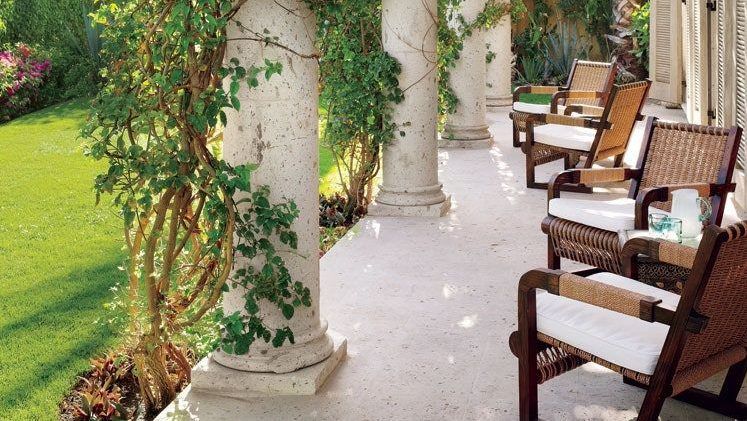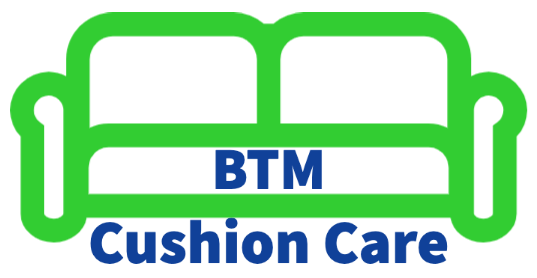Mold and mildew can and will hurt the appearance and performance of patio cushions, but it can be prevented and removed by following a few best practices for outdoor furniture.
Mold and mildew have long been nagging issues for owners of outdoor furniture with cushions that stay outside in all kinds of weather, but it is possible to win the battle against mold and mildew growth. If allowed to go unchecked, it can spell destruction for furniture made using lesser, “value” fabrics without strong performance characteristics and mildew resistance, so we always encourage people to spend the extra money to get furniture made using a performance fabric such as Sunbrella. Doing so will empower you to have the capability to successfully service the fabric, keeping it looking gorgeous and performing beautifully, prolonging the lifetime of the furniture and ultimately saving you money. Before you can successfully prevent and/or remove mold/ mildew growth from your furniture, you must first understand the nature of it.
MOLD 101
There are four necessary components needed for mold/ mildew to form and grow: heat, moisture, mold spores, and an organic food source such as dirt or dust. If any of those four are absent, mildew simply cannot and will not form. If all four components are allowed to gather on an object and remain, however, you can expect it to show its ugly face.
Molds live in the air as minute, hardy spores. As mold spores waft through the air, they bump into objects, such as furniture, walls, ceilings, etc. If the object they hit is dry, they rebound off and continue on. If the object is moist, though, they stick. If allowed to remain for an extended length of time, the spores will “hatch” and begin to feed on any organic matter on the fabric, growing from a single microscopic arm and becoming the visible disturbance we know and hate.
Preventing Mold On Outdoor Cushions
The easiest and most simple way to deal with mold/ mildew on your outdoor furniture is to prevent it from ever forming. This is done by removing one (or more) of the four necessary components of mildew formation. Again, the four necessary components are: mold spores (which are virtually everywhere), moisture, heat, and an organic food source (dirt, soiling. Since mold spores are almost always around, and since heat and moisture (humidity) are often also outside of our control, the best pathway to prevention is by regular cleaning, thereby removing the organic food source, which is the dirt and soiling which get on the fabric.
You want to start by brushing off any loose dirt, dust, and foreign objects on the surface of the fabric prior to beginning the cleaning process. If cushion casings are zippered and therefore removable, they should then be removed from the foam/ filling and machine-washed in cold water and mild detergent (Woolite works well). Always allow the cushion casings to air-dry.
If the cushion casings are not removable, you will need wash the entire cushion seam-to-seam by employing the hand-washing instructions detailed below.
1- Brush off any loose soiling
2- spray the entire surface of the cushion with a solution of water and mild detergent (Dawn Dishwashing Liquid), then gently agitate it with a sift-bristle brush (anything you would feel comfortable using on your car’s paint)
3- rinse thoroughly, then remove as much excess moisture as possible, utilizing an extraction machine such as a Shop-Vac, if possible
4- sit the cushion(s) on end to dry in front of moving air
Removing Mold/ Mildew From Outdoor Cushions

When it comes to removing mold/ mildew from outdoor cushions, it’s best to stick to the science. Scientifically speaking, bleach kills mold/ mildew. While there are many products that claim to remove mold/ mildew, the only ones that truly kill it are those that contain bleach in some form (I know, I know. This is such an unpopular stance and folks often refuse to believe it- but it is true, nonetheless). This is why it is important to make the investment to get furniture made using a performance fabric such as Sunbrella. Such a performance fabric is engineered to withstand being serviced using virtually any kind of harsh chemistry, so mildew would be no match for it. If allowed to grow unchecked, moderate-to-heavy mold/ mildew growth can spell doom for lesser fabrics. It is recommended to perform a spot-test in an inconspicuous are prior to cleaning an unknown brand of fabric using bleach, of course.
It’s simple, really. The removal of mildew from furniture requires a step be added at the beginning of the cleaning instructions above. If machine-washing, simply add 1/2 cup of bleach to the wash and allow the cushion casing(s) to soak for 20 minutes prior to starting the wash. If hand-washing, a step should be added after the brushing of the cushion. In this step, simply spray a25/75 bleach water solution directly onto the mildew, then gently agitate it with a soft-bristle brush. Allow it to sit until the mildew growth dissipates, which will happen within five or ten minutes, depending on the level of growth. Once the bleach has dissipated the mildew growth, continue with the hand-washing instructions, taking care to rinse all of the bleach and cleaning solution away prior to drying.
*One additional note: many fabrics have a finish applied during the manufacturing process which gives the fabric its water repellency. Cleaning with harsh chemistry can deplete the finish, requiring a re-treatment to be applied in order to restore the water repellency. I recommend applying a fabric re-treat such as Tri-Nova (full disclosure: they are not sponsoring this recommendation at all, but we have found it to be effective, so we are passing that knowledge along to you), available on Amazon at the following link: https://www.amazon.com/TriNova-Protector-Upholstery-Protection-Repellent/dp/B01N37A4E4/ref=sr_1_3?crid=DCKEWRU47UE6&keywords=tri-nova+fabric+protector&qid=1642727130&sprefix=tri-nova+fabric+protector%2Caps%2C212&sr=8-3
Bottom Line
Keeping outdoor furniture is a science, but it’s also an art. No two cases are exactly the same. Here at BTM Cushion Care, we are always here to provide detailed recommendations free of charge, if you want. If you are near Anderson, South Carolina, give us a call at 864-209-0803. We just might be the company you’ve been hoping to find. We are happy to help anyone, anytime as well! Just log in to our website at www.cushioncleaning.com and send us a message with your situation and questions. We will contact you with personalized instructions. You can always just have us clean it for you too, of course! In the meantime, we’re here to help you get the most out of your furniture!
Robby
